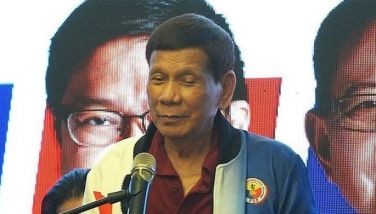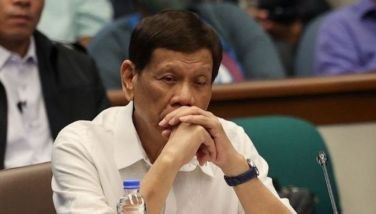Can GPH-NDFP peace talks gain ground in 2015?

Only 18 months remain of President Aquino’s six-year term. He bows out in July 2016.
In the new-year spirit of fulfilling a resolution — or an electoral-campaign promise he made in April 2010 — will P-Noy resume formal peace talks with the National Democratic Front of the Philippines with the goal of signing at least one major agreement before he “retires” from politics in 2016?
Recall that in February 2011 P-Noy did “revive” the GPH-NDFP peace talks that had been suspended since August 2004 by his predecessor, Gloria Macapagal-Arroyo.
Optimism was high. The two panels agreed to accelerate the negotiations’ pace and complete within 18 months all agreements on the remaining three of the four-point agenda adopted under The Hague Joint Declaration, signed in September 1992.
(In 1998 the major accord on the first agenda, the Comprehensive Agreement on Respect for Human Rights and International Humanitarian Law or CARHRIHL, was signed and duly approved by the principals of both sides. The European Parliament hailed it as a “landmark” document. Since 2004 the Norwegian government has provided funding for its implementation. Yet it hasn’t been activated. Reason: Government dithering.)
But the optimism soon evaporated. The scheduled negotiations on the second agenda — social and economic reforms addressing the root causes of the armed conflict, deemed most crucial to the success of the talks — were aborted. Rancorous disputes arose over how to interpret and implement three of the 12 formal agreements (signed between 1992 and 2004) that in February the two panels had reaffirmed in writing.
What a waste! P-Noy had appeared in earnest to fulfill his campaign promise: pursue the peace talks on the basis of a “comprehensive understanding of the root causes of the conflict, under clear policies that pave the way ahead, and driven by a genuine desire to attain a just and lasting peace.”
His positive step was also seen as a loyal son’s gesture to redeem the unrealized vow that his mother, President Corazon Cojuangco-Aquino, made in 1986. To end the protracted armed conflict between the government and the Left revolutionary forces, Mrs. Aquino committed to “address the root causes of the conflict” and called for peace negotiations. The NDFP positively responded.
The peace talks she initiated, however, were disrupted and never revived. Cause: The defense and military establishment, which Mrs. Aquino failed to control throughout her six-year administration, persistently opposed them.
(In contrast, P-Noy apparently enjoys AFP and PNP support, having provided them with continued budget increases, publicly assuring both: “Tell me what you need, and I’ll provide it.” AFP chief Gen. Gregorio Catapang Jr. has declared full support for the peace talks, while his predecessor, Gen. Emmanuel Bautista, is reportedly set to head the GPH negotiating panel.)
Why did P-Noy’s February 2011 initiative dissolve into mutual rancor? I can suggest two reasons:
1. P-Noy’s declared pursuit of his mother’s mantra – addressing the root causes of the armed conflict — lacked his promised “clear policies to pave the way ahead…” (In my Dec. 11, 2010 piece in this space, titled “Let’s hope optimism lasts on GRP-NDFP peace talks,” I precisely warned that absent such clear policies, the talks would likely not progress.)
2. Like his mother, P-Noy wasn’t hands-on in managing the peace talks. He left it to his peace process adviser, Teresita Deles, to handle the task. Thus, rather than get his marching orders from the President who’s his principal, GPH panel head Alexander Padilla deferred to Deles as “my boss.” He echoed her positions both on issues of procedures and substantial agenda.
Deles’ ideological-political bias — or deep-seated antagonism towards the Left — dictated her moves. A few months before the February 2011 formal talks, Deles had stated publicly that she wanted all the previously signed agreements reviewed. Thus, when the two panels proceeded to reaffirm the agreements — which had taken several years of on-and-off negotiations to complete — the GPH panel included several qualifications or reservations in its affirmation statements.
That laid the ground for the ensuing disputes and mutual accusations of insincerity, which in turn led to an impasse in the talks.
Nonetheless, certain factors have kept open the prospect of resuming the formal talks sometime soon.
• The Norwegian government’s sustained efforts, as third party facilitator, to break the impasse. In 2012 and 2013 it sponsored and facilitated informal bilateral meetings to discuss a 2011 proposal for a truce and alliance the NDFP had directly addressed to President Aquino;
• Peace advocates similarly have been pressing both sides to go back to the negotiating table, address the root causes, and honor all agreements. Notable initiatives came from the Philippine Ecumenical Peace Platform. And last year a broad grassroots peace movement called Kapayapaan pitched in; and
• Late last year, a group led by a former GRP panel member reportedly with strong Malacanang links and rapport with the NDFP started to broker a new accelerated timeline, with “doable” targets, for resuming the formal peace talks.
In the last quarter of his term, can P-Noy muster the political will to strive and fulfill his and his mother’s vow to pursue a just and lasting peace?
* * *
Email: satur.ocampo@gmail.com
- Latest
- Trending























